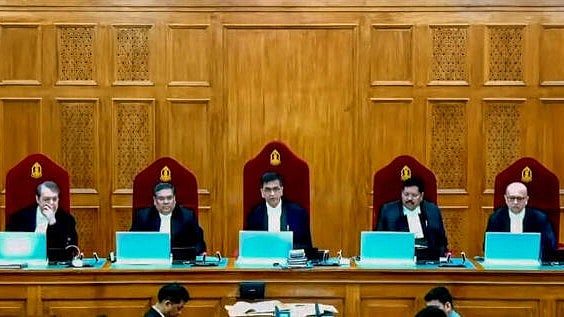
File Photo: The five-judge bench headed by Chief Justice of India Dr D Y Chandrachud and comprising Justices Sanjiv Khanna, B R Gavai, J B Pardiwala and Manoj Mishra during the pronouncement of the verdict on the electoral bond scheme.
Credit: PTI Photo
The Supreme Court has turned the screw on the State Bank of India (SBI) again with a directive to disclose all the details pertaining to Electoral Bonds, including their unique alphanumeric numbers, which would help link the donors to the parties that received the bonds. The bank had claimed, unconvincingly, that it needed time till the end of June to reconcile the data but the court had rejected it and told it to provide the data to the Election Commission by March 12. The court noted that the bank’s petition for more time was silent on what steps it had taken to comply with the order even as all information was available with it. It has left no doubt about the intent of its order by clarifying that it had wanted the bond numbers to be specified.
The details which are in the public domain after the Election Commission released the data on Thursday warrant a closer scrutiny of the facts and figures, the companies, personalities, parties and other entities involved and their connections. The preliminary details give reasons for great concern. A company called Future Gaming and Hotel Services (FGHS), controlled by “lottery king” Santiago Martin, and a Hyderabad-based company, Megha Engineering Infrastructure Ltd (MEIL) and its group companies, are the top donors via Electoral Bonds from April 2019 to January 2024. They have donated bonds worth Rs 1,368 crore and Rs 1,232 crore, respectively. FGHS had been subjected to raids by the Enforcement Directorate (ED) and Income Tax Department; Megha has won large government infrastructure contracts. The Comptroller & Auditor-General (CAG) had warned that the Megha Group had caused glaring losses to the government. At least 14 of the top 30 donors had made their donations around the time they faced ED, Income Tax or other agency action. There are also companies that donated amounts many times their profit. A company that seems linked to Reliance Group made donations 10 times its profit; and another company, based in Kolkata, donated an amount 100 times its profit. There are many other donations from individuals and companies that need explanations.
It is not known with certainty as to which parties received which donations because that critical detail is not yet available. All parties, except the Left parties, have received them. It is known that the BJP received the maximum amount of Rs 6060.5 crore while the Trinamool Congress and the Congress received Rs 1,609.50 crore and Rs 1,421.9 crore, respectively. The linkage between the donor and the recipient needs to be established to know why the donations were made. Available data shows that they were not just political donations, but donations made for specific gains. The court had observed that “there is a legitimate possibility that financial contribution to a political party would lead to quid pro quo arrangements.” The details sought by the court will hopefully throw light on them.
